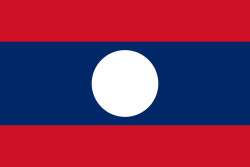
Back الباثيت لاو Arabic Patet Lao Azerbaijani Патэт Лаа Byelorussian Патет Лао Bulgarian Pathet Lao Breton Pathet Lao Catalan Pathet Lao Danish Pathet Lao German Pathet Lao Esperanto Pathet Lao Spanish
| Pathet Lao | |
|---|---|
 Flag of the Pathet Lao | |
| Leaders | Prince Souphanouvong Kaysone Phomvihane Nouhak Phoumsavanh |
| Dates of operation | 1949/1950 – 2 December 1975 |
| Headquarters | Vientiane |
| Ideology | Communism Marxism–Leninism Left-wing nationalism Pro-Vietnam |
| Allies | State allies:
Non-state allies: |
| Opponents | State opponents:
Non-state opponents: |
| Battles and wars | First Indochina War Vietnam War Communist insurgency in Thailand |
| History of Laos | ||||||||||||||
|---|---|---|---|---|---|---|---|---|---|---|---|---|---|---|
 | ||||||||||||||
| Muang city-states era | ||||||||||||||
|
||||||||||||||
| Lan Xang era | ||||||||||||||
|
||||||||||||||
| Regional kingdoms era | ||||||||||||||
|
||||||||||||||
| Colonial era | ||||||||||||||
|
||||||||||||||
| Independent era | ||||||||||||||
|
||||||||||||||
| See also | ||||||||||||||
The Pathet Lao (Lao: ປະເທດລາວ, romanized: Pa thēt Lāo, lit. 'Lao Nation'[1]), officially the Lao People's Liberation Army, was a communist political movement and organization in Laos, formed in the mid-20th century. The group ultimately gained control over the entire country of Laos in 1975, after the Laotian Civil War. The Pathet Lao were always closely associated and dependent on Vietnamese communists and North Vietnam since their foundation, with the group being established after advice from Hanoi to create a Laotian counterpart of the Viet Minh or Viet Cong. During the civil war, it was effectively organised, equipped and even led by the People's Army of Vietnam (PAVN). They fought against the anti-communist forces in the Vietnam War. Eventually, the term became the generic name for Laotian communists. Under orders from Mao Zedong, the People's Liberation Army provided 115,000 guns, 920,000 grenades and 170 million bullets, and trained more than 700 of its military officers.[2]
- ^ Andrea Matles Savada, ed. (1994). "The Pathet Lao". Laos: A Country Study. GPO for the Library of Congress. Archived from the original on June 26, 2022. Retrieved August 8, 2011.
.... The basic stance of this front's propaganda was the united struggle against the French without reference to political parties or ideology. Illustrative of this stance was the use henceforth of the name Pathet Lao (Lao Nation).
- ^ Brazinsky, Gregg A. (2017) Winning the Third World: Sino-American Rivalry during the Cold War, p. 249, The University of North Carolina Press